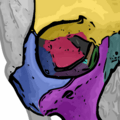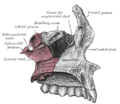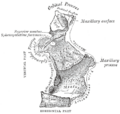Palatine bone facts for kids
The palatine bone is a special bone found in your head. You actually have two of them, one on each side! They are like hidden helpers that form parts of your nose and the roof of your mouth. Think of them as small, L-shaped bones tucked away in your face. They sit right between your upper jaw bone (called the maxilla) and another bone deep inside your skull called the sphenoid bone.
Contents
What is the Palatine Bone?
The palatine bone is a pair of bones, meaning you have one on your left side and one on your right side. These bones are quite small but very important. They help create the structure of your face and skull. They are considered "irregular bones" because they don't have a simple, regular shape like a long bone in your arm.
Where is the Palatine Bone Located?
These bones are located deep within your face. Imagine drawing a line from your nose to your ears. The palatine bones are found behind your upper teeth and nose. They are positioned:
- Behind the maxilla (your upper jaw bone).
- Next to the sphenoid bone (a butterfly-shaped bone at the base of your skull).
- On either side of your nasal cavity.
What Does the Palatine Bone Do?
Even though they are small, the palatine bones have several important jobs. They help form parts of three main areas in your head:
- The nasal cavity (the space inside your nose).
- The hard palate (the bony roof of your mouth).
- A tiny part of the orbit (your eye socket).
Forming the Hard Palate
The hard palate is the front, bony part of the roof of your mouth. You can feel it with your tongue! A big part of it is made by your maxilla, but the palatine bone finishes the job at the back. This hard palate separates your mouth from your nasal cavity, which is super important for chewing, swallowing, and speaking.
Building the Nasal Cavity
The palatine bones also help form the walls and floor of your nasal cavity. This is the space where air flows when you breathe through your nose. They contribute to the complex shape of this area, which helps warm, filter, and moisten the air you breathe before it reaches your lungs.
Contributing to the Eye Socket
A very small part of each palatine bone reaches up to form a tiny section of the floor of your eye socket. This shows how interconnected all the bones in your skull are!
Parts of the Palatine Bone
The palatine bone has two main parts that give it its L-shape:
- Horizontal plate: This flat part forms the back section of the hard palate (roof of your mouth).
- Perpendicular plate: This part stands upright and forms a section of the side wall of your nasal cavity.
It also has smaller parts that stick out and connect to other bones:
- Pyramidal process: This part points downwards and backwards.
- Orbital process: This small part reaches up towards the eye socket.
- Sphenoidal process: This part connects to the sphenoid bone.
Which Bones Does it Connect With?
The palatine bone is like a connector, touching many other bones in your skull. Each palatine bone connects with six other bones:
- The maxilla (upper jaw bone).
- The sphenoid bone (a central skull bone).
- The ethmoid bone (a bone between your eyes).
- The vomer (a bone that divides your nasal cavity).
- The inferior nasal concha (a scroll-shaped bone inside your nose).
- The opposite palatine bone (the other palatine bone on the other side of your head).
It also connects with two other important structures:
- The nasal septum (the wall that divides your nose into two halves).
- The soft palate (the muscular, soft part at the back of the roof of your mouth).
Why is the Palatine Bone Important?
The palatine bone plays a key role in several body functions:
- Breathing: By forming part of the nasal cavity, it helps create the pathway for air.
- Eating and Speaking: As part of the hard palate, it's essential for chewing food and for making certain sounds when you speak.
- Protecting the Eyes: Its small contribution to the eye socket helps protect your eyes.
Understanding bones like the palatine bone helps us appreciate the amazing and complex design of the human body!
Images for kids
See also
 In Spanish: Hueso palatino para niños
In Spanish: Hueso palatino para niños








